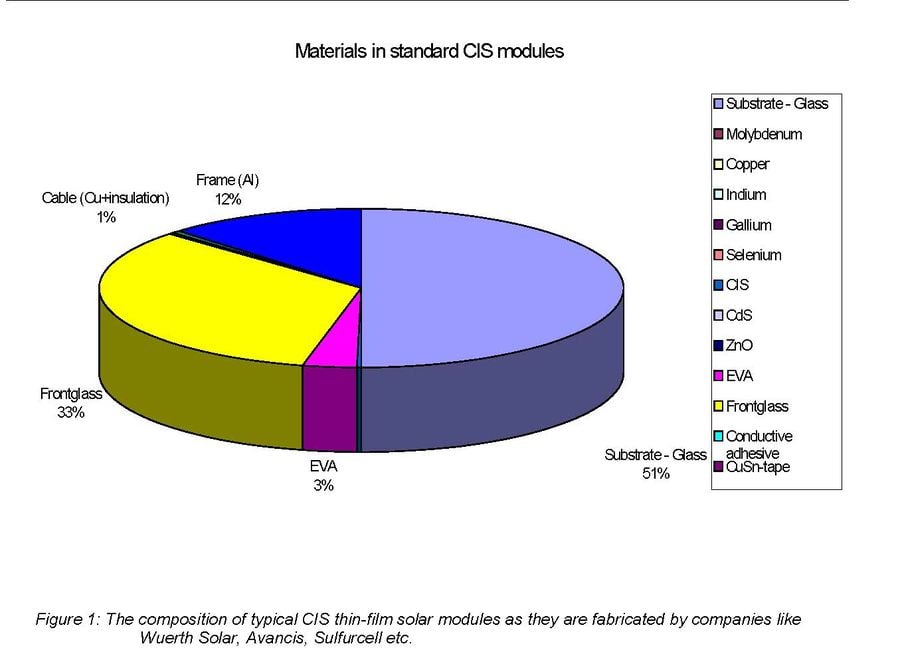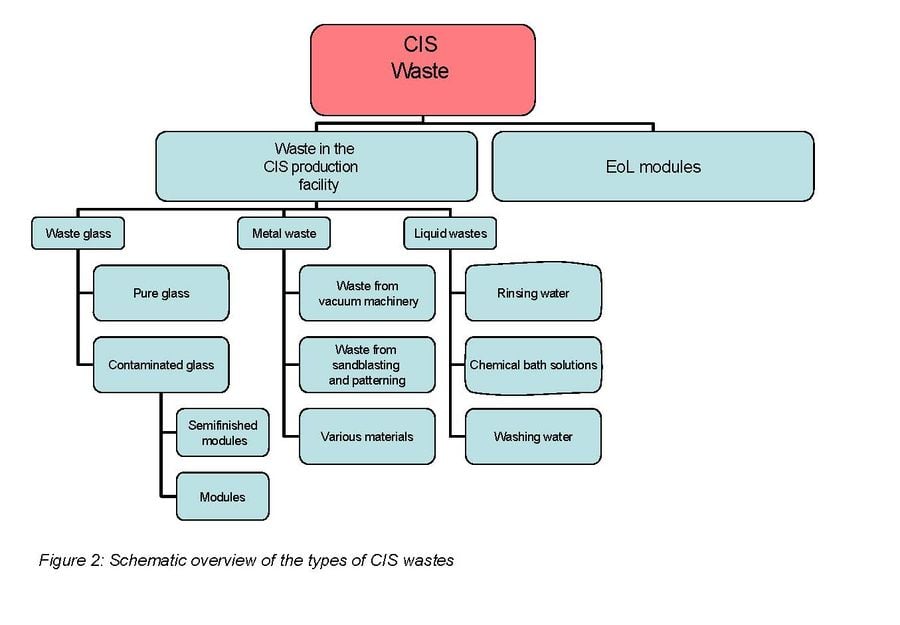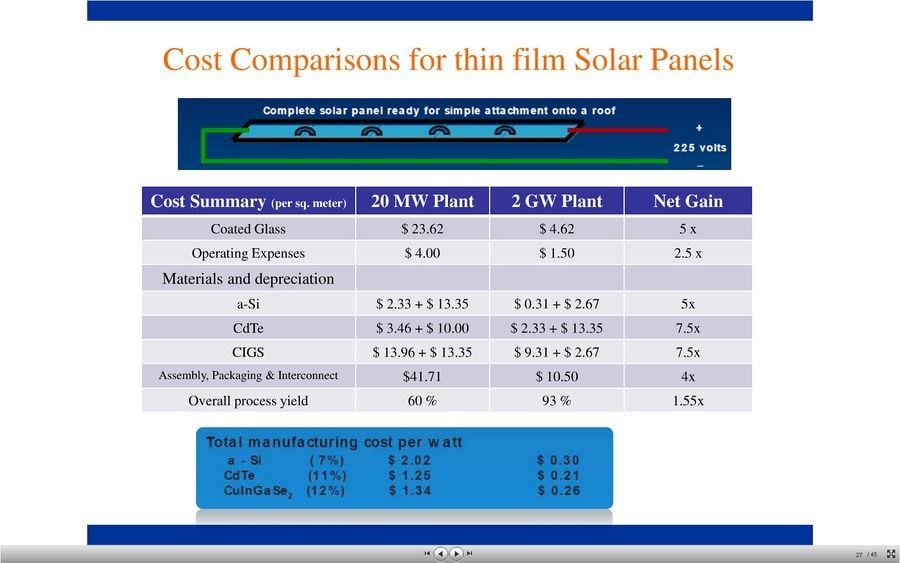| Line 68: | Line 68: | ||
doi: 10.1116/1.578518</ref> | doi: 10.1116/1.578518</ref> | ||
<ref name="[5]">Kemell, M., Ritala, M., & Leskelä, M. (2005). Thin film deposition methods for CuInSe^sub 2^ solar cells. Critical Reviews in Solid State and Materials Sciences, 30(1), 1-1-31. Retrieved from http://search.proquest.com/docview/199605599?accountid=28041</ref> | <ref name="[5]">Kemell, M., Ritala, M., & Leskelä, M. (2005). Thin film deposition methods for CuInSe^sub 2^ solar cells. Critical Reviews in Solid State and Materials Sciences, 30(1), 1-1-31. Retrieved from http://search.proquest.com/docview/199605599?accountid=28041</ref> | ||
<refname="[6]">Goozner, R.E.; Drinkard, W.F.; Long, M.O.; Byrd, C.M.; , "A process to recycle thin film PV materials," Photovoltaic Specialists Conference, 1997., Conference Record of the Twenty-Sixth IEEE , vol., no., pp.1161-1163, 29 Sep-3 Oct 1997 | |||
doi: 10.1109/PVSC.1997.654295 | |||
URL: http://ieeexplore.ieee.org/stamp/stamp.jsp?tp=&arnumber=654295&isnumber=14261<ref> | |||
<ref name="[22]">http://www.slideshare.net/Funk98/how-and-why-is-the-cost-of-electricity-from-cigs-solar-cells-falling-7724815</ref> | <ref name="[22]">http://www.slideshare.net/Funk98/how-and-why-is-the-cost-of-electricity-from-cigs-solar-cells-falling-7724815</ref> | ||
<references/> | <references/> | ||
Revision as of 23:45, 5 October 2011
Team Members
Background



Copper indium (di)selenide (CIS) is a semiconductor material composed of copper, indium, and selenium. CIS production methods include Chemical Vapor Deposition (CVD) and Sputtering as the primary methods of production. Currently the most efficient thin film CIS solar panal has an efficiency of 17.7%.[1]
Deposition Processes
X
Overview of Photovoltaic Recycling
When focusing on end of life PV module recycling it is important to take into account the following. Collection of photovoltaic modules for recycling is a potential problem due to dispersion of the modules. However recycling becomes much more economically feasible where large centralized installations are located. The total concentrations of valuable materials in solar cells are extremely low which could also be a problem. For these reasons it does not seem like it will be economically viable to recycle PV modules for material cost alone. It will be more likely that most of the income for such a plant will be by customers paying for the recycling company to take the modules from them.
When looking at the recycling of waste material from the production process a few key problems come to mind. The amount of waste material per each PV module produced is decreasing drastically. This is because as solar power becomes more main stream current productions methods are being refined to become more efficient and new high efficiency production methods are being developed. It is expected that after the first year of production of a plant capable of producing 2000 tons of solar panels capable of producing roughly 10 MW electricity would only produce 100 tons of waste material a year. [2] The other main problem to consider is that most waste material for the processing of these modules can be refined in house. This puts most of the focus for recycling PV modules towards decommissioned end of life modules.
The overall lack of valuable material at any stage of the production process makes it likely that the best possible thing to hope for is down-cycling. There are almost no financial advantages in recycling the materials to be used in PV modules again. Instead it is most likely that materials recycling will be used as some secondary material. In the case of photovoltaic recycling technology innovations are occurring at an astounding rate. This means that the cost of recycling and the cost of the material itself will continue to fluctuate greatly. On a similar note the cost of putting materials in land fill constantly rises.
Wet Mechanical Recycling Process
Hazardous Materials in some Photovoltaic modules may become harmful if not disposed of properly. To stop this from happening proper end of life recycling and disposal is necessary. For this we have looked at recycling photovoltaic thin film modules using (wet-) mechanical processes. Using the wet process the primary steps for recycling end-of-life modules with firstly intact carrier glass and secondly broken modules are the same. These steps include destruction of the laminate layer, separation of the semiconductor from the glass substrate, enrichment of the semiconductor material, and re-use of the recycled semiconductor materials for the production of more thin film modules. [3]
Destruction of the laminate layer
The destruction of the laminate layer of the module is started by placing PV modules (pieces of 30cm x 30cm and 10cm x 10cm) in a furnace and heating them to temperatures of approximately 500 ˚C. This completely destroyed the EVA (Ethylene Vinyl Acetate)-layer which was the layer between the semiconductors and the back glass. The actual destruction of the laminate is done by crushing the modules into grains of ≤20mm. The particles must be small enough for the attrition to be affective. To achieve small uniform pieces the CIS must be put through a shredder, rotating shear and impact pin mill.[3]
Separation of Semiconductor layer
The separation of the semiconductor layer is done be two different processes depending on in the module has been broken or not. For a module with intact carrier glass the process calls for vacuum blasting. This is a special blasting technique as it uses a vacuum instead of air pressure. This minimizes dust emissions and enables a closed circuit of the blasting medium. For the broken modules Atrittion will be used. The crushed material is put into containers where it is stirred and shearing forces are applied. The shearing forces can remove the modules layers without the addition of any chemicals.[3]
Flotation
Enrichment of the semiconductor material is done by flotation. This separates the various materials from one another. This step uses a series of different flotates and centrifugal forces to filter out the impurities.[3]
The advantages with this procedure include a safer process and the use of very few chemicals. This process uses frictional forces to separate the different materials which means no chemicals are used in the separation process. Without the use of hazardous chemicals one can expect the safety related cost to be decreased. Depending on the final use of the materials there might be less need for further treatment using this process.
Safety
When starting any industrial process environmental, health and safety issues must be addressed. The safety and end of life analysis will be addressed in this section of the project. Federal and California State environmental were taken into consideration for the report used in this project.
For the recycling process we have looked into, the separation of the PV module is done primarily by crushing and shearing forces. This process seemed to be the best from an environmental standpoint. The only additional safety concerns due to this process are concerns that must be dealt with whenever heavy machinery is present so it will not be outlined in this section.
CIS PV material going through certain reclamation processes will likely not be considered hazardous under Federal and California State regulations. End of life CIS PV material will in most cases be unregulated non-hazardous trash. Defective CIS plates will likely be exempt from federal regulation and can probably undergo in-house separation and pre-treatment for reclamation. [4]
With most CIS modules not being classified as hazardous at the end of their life it becomes easier to transport and process these materials. The only problem with that is because the concentration of the potentially harmful materials are so low there won’t likely be any reason to recycle to avoid costly or cumbersome disposal. In the case of a CIS PV module recycling plant the modules taken in by the plant would be exempt from being considered waste [4] . Due to the information listed above the CIS modules that will be dealt with by an outside recycling plant will likely be exempt from hazardous waste regulations. This will likely be true for both defective and end of life modules. This can greatly reduce the cost when planning a CIS photovoltaic recycling plant but one must still take into account the toxic or possibly harmful chemicals that are contained in CIS modules. [4] CIS modules contain an array of potentially harmful materials; however these chemicals are in small amounts. Cadmium is the most harmful of these materials; with the use of cadmium becoming more restricted we have decided to forgo the explanation and problems with this element. Other possible harmful materials associated with CIS modules include selenium, molybdenum, and indium. These are some of the materials that will have to be planned for when starting a recycling plant. The concentration of these materials is such that in most cases there will be minor potential for safety or heath related problems. Reverse logistics companies are already in place to collect, consolidate and transport to manufacturers and recyclers.[4] Safety concerns in the transportation of these modules can be viewed as small due to the facts that there is already an infrastructure in place and the Material will likely not be considered hazardous.
MSDS
References
[5]
[6]
[7]
[8]
[9]
<refname="[6]">Goozner, R.E.; Drinkard, W.F.; Long, M.O.; Byrd, C.M.; , "A process to recycle thin film PV materials," Photovoltaic Specialists Conference, 1997., Conference Record of the Twenty-Sixth IEEE , vol., no., pp.1161-1163, 29 Sep-3 Oct 1997
doi: 10.1109/PVSC.1997.654295
URL: http://ieeexplore.ieee.org/stamp/stamp.jsp?tp=&arnumber=654295&isnumber=14261Cite error: Closing </ref> missing for <ref> tag
- ↑ http://www.azom.com/article.aspx?ArticleID=1165
- ↑ http://www.sciencedirect.com/science/article/pii/S0301421500000914)Keywords
- ↑ 3.0 3.1 3.2 3.3 http://www.sciencedirect.com/science/article/pii/S0921344909002808
- ↑ 4.0 4.1 4.2 4.3 http://www.osti.gov/bridge/servlets/purl/373859-UVKcUc/webviewable/373859.pdf
- ↑ Strand, T.; Kroposki, B.; Hansen, R.; Willett, D.; , "Siemens solar CIS photovoltaic module and system performance at the National Renewable Energy Laboratory," Photovoltaic Specialists Conference, 1996., Conference Record of the Twenty Fifth IEEE , vol., no., pp.965-968, 13-17 May 1996 doi: 10.1109/PVSC.1996.564290
- ↑ A.E. Delahoy, J.S. Britt, and Z.J. Kiss;, "CIS Photovoltaic Technology", October 1998, NREL/SR-520-25713 http://www.nrel.gov/docs/fy99osti/25713.pdf
- ↑ Wagner, S. (2009). NEWS: Single-step solar. The Engineer, (00137758), 12-12. Retrieved from http://search.proquest.com/docview/214077511?accountid=28041
- ↑ Ermer, J.; Gay, R.; Pier, D.; Tarrant, D.; , "Challenges and progress in the scale up of CuInSe2 thin film photovoltaic technology," Journal of Vacuum Science & Technology A: Vacuum, Surfaces, and Films , vol.11, no.4, pp.1888-1895, Jul 1993 doi: 10.1116/1.578518
- ↑ Kemell, M., Ritala, M., & Leskelä, M. (2005). Thin film deposition methods for CuInSe^sub 2^ solar cells. Critical Reviews in Solid State and Materials Sciences, 30(1), 1-1-31. Retrieved from http://search.proquest.com/docview/199605599?accountid=28041